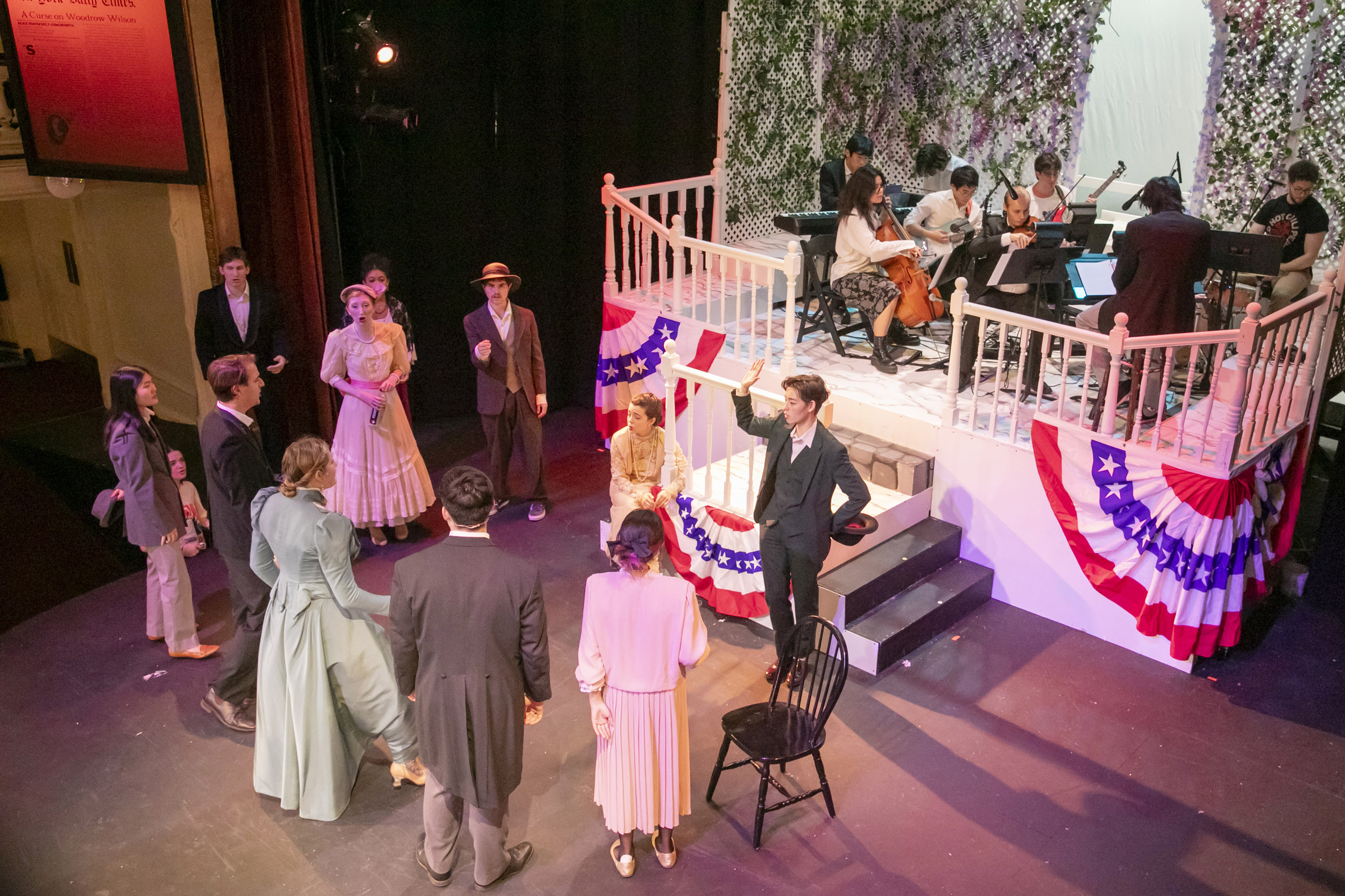
“White House Princess,” an original musical retelling of Alice Lee Roosevelt’s life, is being performed at the Agassiz Theatre.
Jon Chase/Harvard Staff Photographer
Like a Kardashian of the Roosevelt era
Student-written, -directed musical explores, celebrates life of Teddy’s daughter Alice Lee, cousin Eleanor
Think of her as an influencer before Instagram — way before.
Alice Lee Roosevelt, the oldest child of President Theodore “Teddy” Roosevelt, was a huge celebrity in her day. Today, she’s largely forgotten, overshadowed by her cousin Eleanor, who went on to marry another relative, Franklin D. Roosevelt, and become an influential first lady.
But although Alice never tackled the type of social issues as her cousin did, her story remains memorable. This weekend, it will be introduced to a new generation, in the student-written and -directed “White House Princess,” an original musical retelling of Alice’s life, presented through Sunday at the Agassiz Theatre.
Alice, who was born in 1884, “was extremely famous for most of the 20th century, and no one our age knows her name,” said Maureen Clare ’24, one of the new musical’s two playwrights and its executive producer.
The result of a three-year collaboration between Clare, the writer of two Hasty Pudding musicals, and Charlotte Daniels ’24, who is pursuing a dual Harvard-Berklee College of Music degree, the musical comedy is being staged in the era-appropriate Agassiz, which was built in 1904.
“White House Princess” opens with Teddy’s ascension to the presidency after William McKinley’s assassination in 1901 and runs through Alice’s death in 1980. But the central action takes place over the family’s White House years, which ended in 1909.
Alice was then a style-setter and rule-breaker, which the show depicts in part by having her father (played by Jeremy Ornstein ’24) sing about his frustration with his eldest daughter, even as he recognizes that she is just like him.
The feeling, explained Daniels, who is also the show’s vocal-music director, was mutual. “She loved her father, and she really wanted to be like him.”
Bound by the gender roles of the time, Alice could not follow in her father’s political footsteps. Nor did she inherit the 26th president’s passion for reform. “She didn’t fight for suffrage. She didn’t do anything that could be listed on paper,” explained Clare.
Seeking a contemporary example, Clare likens the impetuous and influential Alice to a Kardashian — only in a world where there were few other female celebrities. Unlike her cousin Eleanor or, say, Marie Curie, who had won the Nobel Prize for her pioneering research into radioactivity in 1903, Alice was famous for simply being herself.
Alice “made social change that’s not quantifiable,” said Clare. She cites examples highlighted in the show: “Alice wears pants, and because of the power of her personality, people saw her and said, ‘Oh, maybe I can do that too.’ She crashes a car, and suddenly it’s a lot more normal for a girl to just get behind the wheel.”
“It’s not what she’s going for. It just kind of happens,” said Clare. “It’s what she leaves in her wake that we’re interested in.”
In some ways, the creators agree, their protagonist could come across as selfish. However, Lollie McKenzie ‘26, the show’s director, comes to her defense. “I would question whether we’d ask the same of some male historical figures who did worse and far more selfish things than just trying to seek happiness,” she said.
“She matters enough to spend many, many hours thinking about her and getting inside her head and her family and her life,” continued McKenzie, who noted that she came to this project “from an actor’s perspective.” Although the sophomore last year directed “Post Mortem,” the first-year musical, her previous theatrical experience was largely on-stage, including playing Matilda in the Roald Dahl-inspired musical of the same name in London’s West End.
In “White House Princess,” as in life, Alice’s foil was Eleanor, who appeared more traditional than her rambunctious cousin. (McKenzie called her “a picture-perfect Victorian.”) But Eleanor’s long-term relationship with journalist Lorena “Hick” Hickok broke other rules.
Though Eleanor is today considered a feminist icon and Alice is largely forgotten, both women questioned “how to exist and be happy” despite social restrictions, said Daniels. “Alice isn’t allowed to express herself the way that she wants to and do the things that she wants to. And Eleanor isn’t allowed to love the person she wants,” she said.
Based largely on material from Houghton Library’s Theodore Roosevelt Collection, the production incorporates video and slides of letters projected on the sides of the stage. An accompanying exhibit in the Horner Room of the Agassiz Theatre will display a selection of archival material, which audiences can view before and after the show.
Following Saturday’s matinee, Harvard President Emerita Drew Gilpin Faust will join the two playwrights for a talk-back about writing about female historical figures.
“One thing about the show is everyone’s going to get something from it,” said McKenzie. “Whether it’s learning more about the historical period or just purely enjoying and having fun.”
“White House Princess” runs through Sunday at the Agassiz Theatre in Cambridge. Faust’s talk follows the 2 p.m. matinee.




